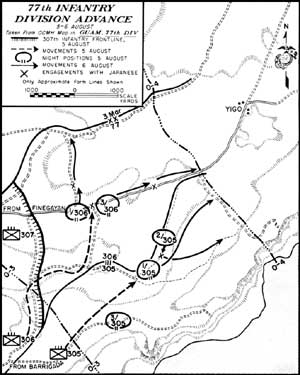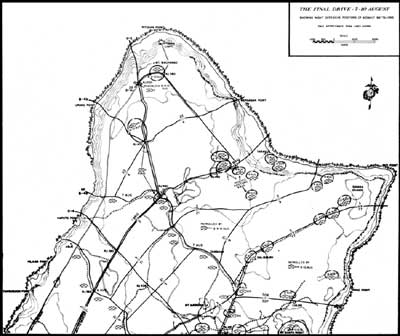| Marines in World War II Commemorative Series |
|
LIBERATION: Marines in the Recapture of Guam by Cyril J. O'Brien Beginning of the End On 4 August, the new frontlines and scheme of maneuver were being set up to keep pressure on General Obata and his holdouts, and make a place for General Shepherd and his brigade. During the afternoon, the brigade reached its northern assembly area and General Shepherd set up his CP near San Antonio. In the final advance north, the brigade would be on the left with its inland flank within a mile of the western beaches. The 3d Division would be in the center deploying its units on a three-regiment front which would swerve to the east to take in the whole northern end of the island and as well support the 77th Division. The Japanese now faced an overwhelming number of attack forces. And there would be plenty of help from the sea and from the air. General Bruce's soldiers made the principal corps drive to destroy the remaining Japanese and attacked Mount Santa Rosa. Priority of fires of corps artillery, air support, and ships gunfire was now given to the Army. These new arrangements were to take effect on 7 August. Making new strides to end the campaign, the 3d and 21st Marines progressed handily but the 9th Marines kept running into dense jungle that was such a tangled mess that tanks passed each other 15 feet apart without knowing the other was there. The division accelerated its advance in battalion columns. On 6 August, it had progressed 5,000 yards along the road to Ritidian Point, the end of the island and the end of the battle for Guam. As that evening fell, the 3d Division was in visual contact with the 77th Infantry Division, wherever the all-encompassing jungle allowed.
Meanwhile, heavy Seventh Air Force bombing as well as artillery and naval shelling of enemy areas had been going on for days. Night fighters were now assigned to support the advance, so even darkness afforded the Japanese no protection. By that same 6 August, the defense line that General Obata had set across Guam had been shattered and overrun. Only isolated pockets now existed before Santa Rosa. No American commander could say on 7 August when the fight for Guam would be over. General Bruce in his attack first to Yigo and then Santa Rosa would have a relatively fresh regiment, the 306th, which had come up from the south where it had patrolled with the brigade. It was in contact with the 9th Marines on the division boundary. Colonel Douglas C. McNair, 77th Division chief of staff, was there, too, seeking a site for a division CP and was killed by a sniper. Colonel McNair's father, Lieutenant General Leslie J. McNair, was killed in France 12 days earlier during an American bombing raid. The attack on Mount Santa Rosa began at noon, 7 August. Behind the rumble of artillery and rattle of tanks, answered in kind by the enemy, the 77th took Yigo, the door to Santa Rosa, and continued General Bruce's wheeling maneuver. Bulldozers blazed trails, and tanks and infantry overran machine gun positions. The 77th was dug into positions on the night of 7-8 August ready for the final attack on the mountain. The expected big Japanese counterattack still did not come. The rapid advance of the Americans accompanied by heavy artillery support likely forestalled that forelorn hope. Two regiments, the 305th and 307th, proceeded rapidly on 8 August. By 1240, the northern half of Mount Santa Rosa was in American hands, and the troops moved to secure the rest of the mountain. By 1440 the Army had reached the cliffs by the sea and could look right down to the ocean. The 306th infantry had also completed an enveloping move to take the northern slopes of Mount Santa Rosa.
Only 600 enemy bodies were found after the two-day fight for Yigo and Santa Rosa. Yet, estimates of the enemy personnel at Santa Rosa had been as high as 5,000. So this meant that enemy troops in significant number now infested the jungled terrain everywhere on Guam. Worse, some enemy tanks were also unaccounted for. Enemy survivors of the Mount Santa Rosa battle kept drifting into the 9th Marines lines on the Army flank, slowing the regiment's advance. Sharp-eyed Marines noted more than a smattering of enemy movement near a particular hill in the Army zone. This was believed to be the command post area of General Obata. The 3d Marines on the left of the division's zone had progressed with the same occasional enemy opposition. A 19-man roadblock held up the Marines, but was taken out quickly. Searching a corridor between the 3d and the 9th Marines, the 21st Marines came upon the bodies of 30 Guamanians near Chaguian. They had been beheaded. The brigade had it a little easier on the far west, for it found negligible resistance as it advanced along fairly good trails. On 8 August, a patrol of the 22d Marines reached Ritidian Point, the northernmost point of the island. Moving along a twisting cliff trail to the beach, the Marines encountered less-than-aggressive Japanese defenses which they quickly overcame. General Shepherd's 1st Provisional Marine Brigade had the distinction of being first to reach both the southernmost point of the island in the early days of the campaign and the northernmost section of Guam at Ritidian Point at this time.
General Shepherd's Marines began vigorously patrolling the area it they occupied, but found few Japanese. As a result, General Geiger reduced the amount of naval gunfire placed on the area, while Saipan-based Seventh Air Force P-47's made their last bombing and strafing runs on Ritidian Point. The 22d Marines was down below the cliffs at Ritidian, scouring along the beaches where there are many caves. The 4th Marines was on the north coast at Mengagan Point and tied by patrols to the 22d Marines. At 1800, 9 August, General Shepherd declared organized resistance had ceased in his zone. It was not so easy for the 3d Marines. On the night of 8-9 August near Tarague, the regiment was hit by a last-resort Japanese mortar and tank attack. Marine antitank grenades and bazooka rockets were wet and ineffective and the Japanese blazed away with impunity and then ducked back into the woods. Amazingly, when Major William A. Culpepper, commanding the 2d Battalion (Lieutenant Colonel de Zayas had been killed on 26 July), counted heads, he found that he had suffered not a single casualty. Patrols of the 9th Marines advanced to Pati Point, the northeast projection of the island. Intelligence sources then reported to Colonel Craig that a mass of Japanese (maybe 2,000) troops were holed up at Savana Grand, a wild tract of jungle, coconut trees, and high grasses near the coast. Colonel Craig did not want to risk casualties so close to the end of the campaign, so the artillery supporting the 9th Marines fired a total of 2,280 rounds. The few Japanese survivors were either killed or became prisoners. The final American positions formed along the coast. By nightfall of 8 August, Colonel Craig's Marines could wave to the soldiers of the 306th patrolling to their south. General Geiger was not ready to declare Guam secure until a pocket of tanks still existing in the 3d Division zone was wiped out. That had to be done by the 10th, for that was the day Admiral Nimitz was scheduled to arrive on a visit. There were tanks indeed and the task of finding and eliminating them was given to Major Culpepper's 2d Battalion, 3d Marines. Advancing at 0730, the battalion and a platoon of American Sherman tanks soon found two enemy mediums firing, only 400 yards up the trail the Marines were following. The Shermans left their counterparts black and burning. Seven more enemy mediums were abandoned. A Japanese infantry platoon withdrew to the coastal cliffs and was killed there. On that day, 10 August, at 1131 as he learned that the last Japanese tanks still in action had been destroyed, General Geiger declared all organized resistance on Guam had ended. It was a great day for the Guamanians. The island was theirs again.
It was also the next to the last day for General Obata. His Mount Mataguac position was strongly defended, so much so that when the 306th had tried to force it earlier it failed. On the morning of 11 August 1944, when the general knew his headquarters had been discovered and that his enemy was coming for him, Obata signalled to his emperor:
The 306th made the last assault supported by tanks and demolition squads. The enemy defenders killed seven Americans and wounded 17 before they went down to defeat, buried in the rubble of blown caves and emplacements. General Obata took his own life or was killed sometime during those last hours of the battle of Guam. Major General Henry L. Larsen assumed command of the Guam Island Command at 1200, 15 August. Under him, and largely with the forces of the 3d Marine Division, the mopping up continued. Part of Japan's terrible cost on Guam was the 10,971 bodies already counted. Yet there were some 10,000 Japanese still on the island. At first some of these men fought and staged ambushes, and a few sniped at the Americans, but soon the remaining Japanese sought only one thing—food! Most of the others fled when encountered. The Japanese now had no central command. They starved, died of dysentery, became too weak to flee, and then blew themselves up with the one precious grenade which they saved to take their own lives. Aggressive American patrols were soon killing or capturing 80 Japanese soldiers and sailors a day. A daring few stole into Marine food storage areas at night. One soldier scribbled: "All around me are enemy only. It takes a brave man indeed to go in search of food." In addition to the battlefield casualties, more than 8,500 Japanese were killed or captured on Guam between August 1944 and the end of the war in August 1945.
In the 21 days of the Guam campaign ending 10 August, Marine units of the III Amphibious Corps reported 1,190 men killed in action, 377 dead of wounds, and 5,308 wounded. The 77th Division's casualties were 177 soldiers killed and 662 wounded. The Army and the Marines were a closely knit team in the recapture of Guam. It is reputed that General Holland Smith was the first to refer to General Bruce's troops as the "77th Marines." Major Aplington, a battalion commander in the 3d Marines, commented on the soldiers:
On the same busy day, 10 August, only hours after Major Culpepper's battalion had knocked out the last of the Japanese tanks, the Indianapolis (CA 35) steamed into Apra Harbor with Marine Corps Commandant Lieutenant General Alexander A. Vandegrift on board, accompanying Admiral Nimitz. On 15 August, Admiral Nimitz directed that his for ward CinCPac-CinCPOA headquarters be established on Guam, and from here, he directed the rest of the Pacific War. Soon after, from airfields on Guam, as well as those on Tinian, B-29s were blasting the Japanese home islands. Hard fighting was yet to be experienced by Marine divisions on Peleliu, Iwo Jima, and Okinawa. But whether they knew it or not, the end of the war was less than a year away.
|











